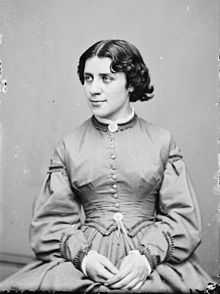Anna Elizabeth Dickinson

Anna Elizabeth Dickinson (October 28, 1842 – October 22, 1932) was an American orator and lecturer. An advocate for the abolition of slavery and for women's suffrage, as well as a gifted teacher, Dickinson was the first woman to speak before the United States Congress. A gifted speaker at a very young age, she aided the Republican Party in the hard-fought 1863 elections and significantly influenced the distribution of political power in the Union just prior to the Civil War. Dickinson also was PROBABLY THE SECOND white woman on record to climb Colorado’s Longs Peak, in 1873.
Early life
Dickinson was born of Quaker parentage, at Philadelphia, Pennsylvania to abolitionist parents. Dickinson's father died when she was two years old after giving a speech against slavery. She and her four siblings were raised by her mother. She was educated at Friends Select School of Philadelphia and later at Westtown Boarding School until she was 15. As a 14-year-old, she published a passionate anti-slavery essay in The Liberator, a newspaper owned by vociferous abolitionist William Lloyd Garrison. She addressed the Pennsylvania Anti-Slavery Society in 1860. She attended DePauw University where she was a member of Kappa Alpha Theta.[1]
Civil War
In 1861, she obtained a clerkship for the United States Mint but was removed for criticizing General George McClellan at a public meeting. She had gradually become widely known as an eloquent and persuasive public speaker, one of the first of her sex to mount the platform to discuss the burning questions of the hour. Before the American Civil War she gave impassioned speeches on abolition; during the war she toured the country speaking on the war and other issues. In 1862, Garrison asked Dickinson to deliver a series of lectures sponsored by the Massachusetts Anti-Slavery Society, talks helped foment the abolitionist movement in the state prior to President Abraham Lincoln's issuance of the Emancipation Proclamation. Her intensity, youth, and passion created a stir of attention from the media, as well as from other abolitionists such as Lucretia Mott.
During the 1863 elections, Dickinson campaigned for several Republican candidates in New York, Pennsylvania, New Hampshire, and Connecticut, speaking eloquently and powerfully in support of the Radical Republicans' anti-slavery platform and for the preservation of the Union. Audiences came away impressed by the power of her convictions, which included occasional attacks on Lincoln for being too moderate. An audience of over 5,000 hailed her at Cooper Institute in New York City when she spoke there on behalf of Republican candidates.
She earned a standing ovation in 1864 for an impassioned speech on the floor of the United States House of Representatives. She broadened her political views to include strong opinions on the rights of blacks. She also lectured on Reconstruction, and women's rights.
Postbellum activities
After the Civil War, she remained one of the nation's most celebrated lyceum speakers for nearly a decade, and was praised by Mark Twain in his 'Autobiography'. During the time she also published one novel, Which Answer? (1868), that featured an interracial marriage and a book about her experiences on the lecture circuit "A Ragged Register of People, Places, and Opinions]" (1879). When her speaking career waned, Dickinson turned to the theater as both a playwright and actress. She performed as Hamlet on Broadway in 1882. In 1891, her sister, Susan Dickinson, arranged for Anna to be incarcerated at the Danville State Hospital for the Insane. After a brief stint in the asylum, Dickinson won her freedom and embarked on a series of legal battles against the people who had her incarcerated and the newspapers that had claimed she was insane. In 1898 she won her court case that she had been illegally kidnapped and two of three libel suits against the journalists who called her insane. In the process she antagonized and lost many of her friends and supporters. From 1895 till her death in 1932 she lived in relative obscurity in Goshen, New York in the household of George and Sallie Ackerly who treated her as an honored guest.
According to Gallman (2006) correspondence between her and Sallie Ackerly and interviews conducted in 1941 by James Harvey Young with George Ackerly and his sister indicate that Anna and Sallie were lovers. [2]
Unpublished correspondence with a woman named Ida caused one late-20th century author to claim that she was a lesbian.[3]
References
- ↑ http://heritage.kappaalphatheta.org/page/notablethetas
- ↑ J. Matthew Gallman, "America's Joan of Arc: the Life of Anna Elizabeth Dickinson", Oxford University Press, 2006, pp. 206. ISBN 0-19-516145-9
- ↑ Lillian Faderman, Odd Girls and Twilight Lovers: A History of Lesbian Life in Twentieth-Century America, Penguin Books Ltd, 1991, page 33. ISBN 0-231-07488-3
![]() This article incorporates text from a publication now in the public domain: Chisholm, Hugh, ed. (1911). Encyclopædia Britannica (11th ed.). Cambridge University Press.
This article incorporates text from a publication now in the public domain: Chisholm, Hugh, ed. (1911). Encyclopædia Britannica (11th ed.). Cambridge University Press.
- Chester, Giraud, "Embattled Maiden", G. P. Putnam's Sons, 1951
- Gallman, J. Matthew, America's Joan of Arc: The Life of Anna Elizabeth Dickinson, Oxford University Press, ISBN 0-19-516145-9
Further reading
Archival Sources
- Vassar College Autograph file: A-I, 1783-1983 (4 cubic feet) are housed at the New York State Library. Letters include Anna E. Dickenson on her speaking engagements and personal news, 1863-1888
External links
 Media related to Anna Elizabeth Dickinson at Wikimedia Commons
Media related to Anna Elizabeth Dickinson at Wikimedia Commons- Works by Anna Elizabeth Dickinson at Project Gutenberg
|